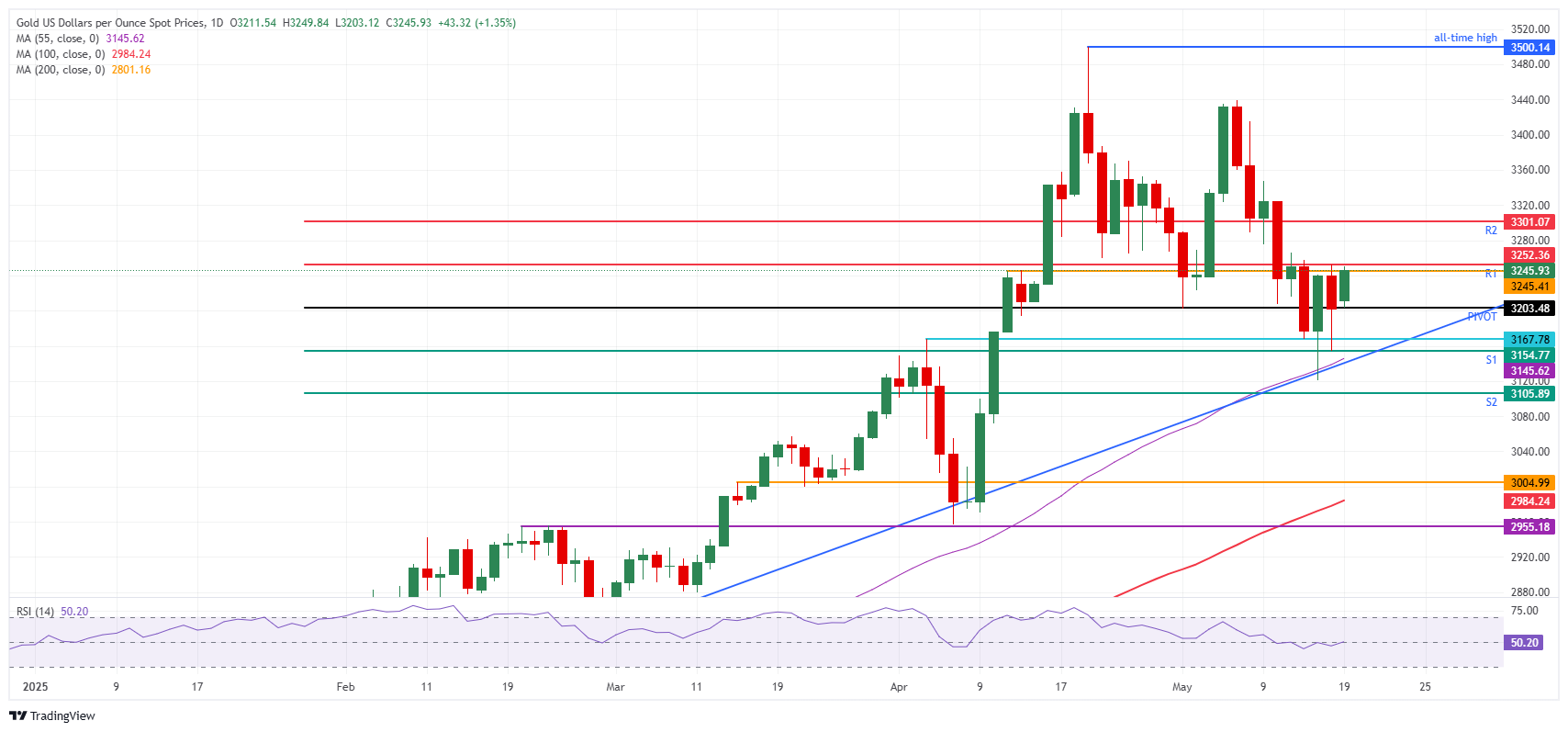- The price of gold rises more than 1% on Monday after Moody’s reduced the credit rating of US sovereign debt on Friday, which sent upward yields.
- Raphael Bostic’s comments, a member of the Fed, indicate that the chain effects on the US economy could feel for this credit reduction.
- Gold is negotiated in an adjusted range, staying above $ 3,230 to start the week.
The price of gold (Xau/USD) rises more than 1% on Monday and reaches $ 3,243 at the time of writing, with three main themes at stake on Monday. Tensions are increasing in the Middle East with Israel undertaking another massive terrestrial offensive. Military action occurs only days after the US president Donald Trump visited the Middle East, although he did not visit Israel.
The second main engine is the bond market, where several pension funds and fixed -income investors (bonds) will need to reorganize their holdings after the Moody’s qualification agency reduced the credit rating of the US sovereign debt after the market closure on Friday. By lowering the US rating of ‘AAA’ A ‘AA1’, Moody’s said that successive US administrations have failed to reverse the growing deficits and interest costs, reports the BBC. This could have repercussions for the Federal Reserve (Fed) and the US yields, where non -American parts will ask for higher rates in search of more guarantees before considering buying US debt.
The last engine this Monday is rather an obstacle to precious metal. The president of the United States, Trump, torpedoed the peace conversations in Istanbul last week when he said in the Air Force One that an agreement could not be reached without his participation and that of the Russian president, Vladimir Putin. Both presidents will have a phone call on Monday to discuss the matter, which could represent an obstacle to gold if an advance materializes.
What moves the market today: Fed officials warn about the chain effect
- The president of the Atlanta Federal Reserve Bank, Raphael Bostic, has issued warnings on Monday that chain effects could affect the US economy following this reduction. He suggested to wait between 3 and 6 months before uncertainty settles, since the rates transition could take longer and affect consumer behavior, says Bloomberg.
- A Chinese billionaire inmate whose gold operations have resulted in a striking benefit has now become the largest copper bullish in the country, accumulating a value of almost 1,000 million dollars in a market shaken by the growing competition between the US and China, Bloomberg reports.
- Gold is rising as operators respond to the new uncertainty surrounding the US perspective after Moody’s reduced the sovereign credit qualification of the nation. The increase in general anxiety levels may also be reviving concerns about the potential of less economic growth in the US already global level, given the decrease in crude oil contracts, Bloomberg reports.
- “While we recognize the significant economic and financial strengths of the United States, we believe that these no longer completely counteract the decrease in tax indicators,” Moody’s added in his statement, reports Reuters.
- The 30 -year performance of the US rose to 5% on Monday after the moody’s reduction, returning to April levels.
Technical analysis of the price of gold
Did Moody’s only put a shot in the US wound? Rather, Moody’s’s call is what several operators and analysts were predicting: USA is accumulating debt more quickly than you are seeing income. At some point that needs to be approached, and although President Trump could be upset with Moody’s, there is a much greater concern: the activity and domestic economy with high rates and the Fed having your hands tied.
On the positive side, the crucial technical level at 3,245 (maximum of April 1) is acting as resistance and could be difficult to recover. Once exceeded, R1 resistance at $ 3,252 and R2 resistance at $ 3,301 are the following levels to be monitored, although an important catalyst would be needed to get there.
On the other hand, the daily pivot point is at $ 3.203, in line with the round figure of $ 3,200. In the event that this level is not maintained, a downward movement is expected to test the support area around $ 3,150, with the maximum of April 3 in $ 3,167 and the intradic support S1 at $ 3,155, before the simple mobile average (SMA) of 55 days at 3,151 $.

Xau/USD: Daily graphic
US interest rates
Financial institutions charge interest rates on loans to borrowers and pay them as interest to savers and depositors. They influence the basic types of interest, which are set by central banks based on the evolution of the economy. Normally, central banks have the mandate to guarantee the stability of prices, which in most cases means setting as an objective an underlying inflation rate around 2%.
If inflation falls below the objective, the Central Bank can cut the basic types of interest, in order to stimulate credit and boost the economy. If inflation increases substantially above 2%, the Central Bank usually rises the interest rates of basic loans to try to reduce inflation.
In general, higher interest rates contribute to reinforce the currency of a country, since they make it a more attractive place for world investors to park their money.
The highest interest rates influence the price of gold because they increase the opportunity cost of maintaining gold instead of investing in an asset that accrues interest or depositing effective in the bank.
If interest rates are high, the price of the US dollar (USD) usually rises and, as gold quotes in dollars, the price of low gold.
The federal funds rate is the type to a day that US banks lend each other. It is the official interest rate that the Federal Reserve usually sets at its FOMC meetings. It is set at a fork, for example 4.75%-5.00%, although the upper limit (in this case 5.00%) is the aforementioned figure.
Market expectations on the interest rate of the Federal Reserve funds are followed by the Fedwatch of the CME tool, which determines the behavior of many financial markets in the forecast of future monetary policy decisions of the Federal Reserve.
Source: Fx Street
I am Joshua Winder, a senior-level journalist and editor at World Stock Market. I specialize in covering news related to the stock market and economic trends. With more than 8 years of experience in this field, I have become an expert in financial reporting.







